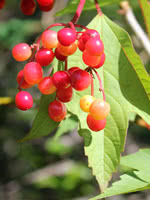Mon-Fri 9am - 5pm Mountain time
Highbush Cranberry vs Ninebark
Viburnum opulus var. americanum (trilobum)
Physocarpus opulifolius
CUSTOM GROW
Highbush Cranberry produces attractive white flowers in late June and bears edible fruit that matures to a bright red colour in the late summer.
This shrub, native to much of Canada, is fast growing, and its fruit can be eaten raw or cooked into a sauce.
Ninebark is a small, multi-stemmed shrub, that is used to add texture or colour to any yard.
It features flaky, cinnamon-brown bark, attractive white flowers, and long, maple-like leaves.
Highbush Cranberry Quick Facts
Ninebark Quick Facts
In row spacing: 0.6 m (2.0 ft)

